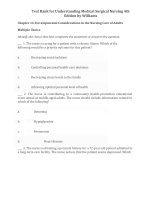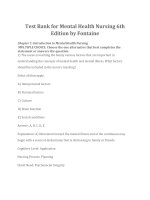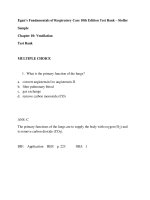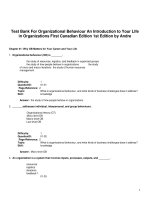link full download test bank for pediatric nursing an introductory text 11th edition by price
Bạn đang xem bản rút gọn của tài liệu. Xem và tải ngay bản đầy đủ của tài liệu tại đây (619.02 KB, 29 trang )
Test Bank for Pediatric Nursing An Introductory Text 11th
Edition by Price
Chapter 13: Neurologic and Sensory Disorders
Testbank
MULTIPLE CHOICE
1. The nurse is aware that during early childhood cerebral blood flow
and oxygen consumption:
a.
Are twice that of the adult
b.
Are scant due to rapid physical growth
c.
Fluctuate dependent on growth cycles
d.
Are impossible to measure
ANS: A
In the first several years of the child’s life, cerebral blood flow and oxygen
consumption are almost twice that of the adult. Brain growth is measured by
head circumference.
DIF: Cognitive Level: Comprehension
REF: p. 243
OBJ: 2
TOP: Brain Growth
KEY: Nursing Process Step: Planning
MSC: NCLEX: Physiological Integrity: Physiological Adaptation
2. The newborn nursery nurse takes special care in feeding a child with
a possible intracranial hemorrhage because these children:
a.
Will be likely to engorge themselves
b.
Need more nutrients than other babies
c.
Have a poor sucking reflex
d.
Need cuddling and nurturing
ANS: C
Babies with intracranial hemorrhage have a poor sucking reflex. They do not
need any more nutrients or affection than any other child. They are not likely to
eat too much because of their poor sucking reflex and the tendency to vomit.
DIF:
Cognitive Level: Application
TOP: Intracranial Hemorrhage
Implementation
REF: p. 244
OBJ: 3
KEY: Nursing Process Step:
MSC: NCLEX: Physiological Integrity: Basic Care and Comfort
The nurse recognizes this posture in a child with a head injury as being indicative
of injury to the:
a.
Midbrain
b.
Cerebral cortex
c.
Brainstem
d.
Skull
ANS: A
This is the decerebrate posture, which indicates injury to the midbrain.
DIF: Cognitive Level: Application
REF: p. 245
OBJ: 3
TOP: Decerebrate Posturing
KEY: Nursing Process Step: Assessment
MSC: NCLEX: Physiological Integrity: Physiological Adaptation
4. A 12-year-old is admitted to the emergency department after a head injury.
His admission vital signs are: T: 98.2°, P: 68, BP: 96/56, and R: 16. Select the
set of vital signs that would indicate to the nurse that there is increasing
intracranial pressure (ICP):
a.
T: 98.2°, P: 66, BP: 100/60, R: 18
b.
T: 98.4°, P: 68, BP: 112/72, R: 16
c.
T: 98.4°, P: 60, BP: 118/68, R: 14
d.
T: 99°, P: 66, BP: 98/54, R: 14
ANS: C
The pulse and respirations are dropping, the systolic blood pressure is rising,
and the pulse pressure is getting wider. These are all indicators of increasing ICP.
DIF:
Cognitive Level: Analysis
TOP: Increasing Intracranial Pressure
REF: p. 246
OBJ: 3
KEY: Nursing Process Step: Assessment
MSC: NCLEX: Health Promotion and Maintenance: Prevention and Early Detection
of Disease
5. The mother of a 3-year-old who received a mild concussion during a fall
from his tricycle the previous day tells the home health nurse that she is
worried about his temperature elevation of 100°. The nurse’s best response
will be based on the knowledge that the temperature elevation:
a.
Is an indication of an infection
b.
Suggests that there is increasing intracranial pressure
c.
Could be a sign that there is an intracranial bleed
d.
Is not uncommon during the first 2 days after trauma
ANS: D
Mild temperature elevations in young children during the 2 days following a
trauma are not uncommon.
DIF:
Cognitive Level: Application
TOP: Elevated Temperature
REF: p. 247
OBJ: 2
KEY: Nursing Process Step: Assessment
MSC: NCLEX: Physiological Integrity: Physiological Adaptation
6. When the mother of a child who has just received a ventriculoperitoneal
(VP) shunt for the relief of hydrocephalus asks the nurse what happens to all
the fluid that is pumped into the peritoneal space, the nurse bases the
response on the knowledge that the fluid is:
a.
Absorbed into the circulating volume and excreted
b.
Taken up by the fat cells in the abdomen
c.
Ultimately stored in the liver
d.
Stored in the lymphatic system
ANS: A
The fluid from the ventricles is absorbed into the circulating volume and excreted.
DIF: Cognitive Level: Comprehension
REF: p. 248
OBJ: 6
TOP: Ventriculoperitoneal Shunt
Implementation
KEY: Nursing Process Step:
MSC: NCLEX: Physiological Integrity: Physiological Adaptation
7. The nurse explains that once a ventriculoperitoneal (VP) shunt is in place
the CSF is prevented from back-flowing by:
a.
Placement of a one-way pressure valve
b.
A system of locks along the shunt tubing
c.
Organ movement in peritoneal space
d.
Gravity
ANS: A
A one-way pressure valve that responds to a preset intraventricular pressure allows
the fluid to be removed under its own pressure, but does not allow back-flow.
DIF: Cognitive Level: Comprehension
REF: p. 248
OBJ: 6
TOP: One-way Pressure Valve
Implementation
KEY: Nursing Process Step:
MSC: NCLEX: Physiological Integrity: Basic Care and Comfort
8. The nurse includes in the plan of care for a 5-month-old hydrocephalic
baby an intervention to prevent hypostatic pneumonia, which would be:
a.
Monitor oxygen per nasal cannula
b.
Keep the baby hydrated by offering water between
feedings
c.
Change the baby’s position every 2 hours
d.
Position the baby in an upright position
ANS: C
Frequent position changes are helpful in preventing hypostatic pneumonia
and pressure sores.
DIF: Cognitive Level: Comprehension
REF: p. 249
OBJ: N/A
TOP: Hypostatic Pneumonia
KEY: Nursing Process Step: Planning
MSC: NCLEX: Physiological Integrity: Basic Care and Comfort
9. The nurse is aware that the most appropriate position for 1-day
post-operative child with a ventriculoperitoneal (VP) shunt is:
a.
High Fowler’s
b.
Side-lying
c.
Flat on the back
d.
Upright
ANS: C
The most appropriate position for a 1-day post-operative child with a VP shunt is
on the back to prevent a too-rapid reduction of fluid from the head. Rapid fluid loss
from the ventricles may lead to seizures or cortical bleeding.
DIF: Cognitive Level: Application
REF: p. 249
TOP: Post-operative Ventriculoperitoneal Shunt
KEY: Nursing Process Step: Planning
MSC: NCLEX: Physiological Integrity: Basic Care and Comfort
OBJ: N/A
10. The nurse clarifies that the difference between a myelomeningocele and
a meningocele is that the cyst of a myelomeningocele contains:
a.
Membranes and CSF
b.
Membranes only
c.
Membranes, CSF, and the spinal cord
d.
CSF only
ANS: C
The myelomeningocele contains membranes, CSF, and the spinal cord. This neural
tube lesion can be the size of a walnut or as large as the baby’s head.
DIF: Cognitive Level: Comprehension
TOP: Myelomeningocele
Implementation
REF: p. 250
OBJ: 7
KEY: Nursing Process Step:
MSC: NCLEX: Physiological Integrity: Physiological Adaptation
11. Studies have shown that the incidence of neural tube defects has been
greatly reduced by the use of:
a.
Vitamin A
b.
Vitamin B
c.
Niacin
d.
Folic acid
ANS: D
There has been a steady decline of cases of neural tube defects because of daily
use of folic acid.
DIF: Cognitive Level: Knowledge
TOP: Folic Acid
REF: p. 250
KEY: Nursing Process Step: N/A
OBJ: N/A
MSC: NCLEX: N/A
12. The nurse takes special caution in positioning the infant with a
myelomeningocele in order to:
a.
Protect the sac
b.
Support the back
c.
Facilitate feeding
d.
Prevent vomiting
ANS: A
The primary preoperative focus in the nursing care of a child with
a myelomeningocele is to protect the sac.
DIF: Cognitive Level: Comprehension
TOP: Positioning
REF: p. 251
OBJ: 7
KEY: Nursing Process Step: Planning
MSC: NCLEX: Physiological Integrity: Reduction of Risk
13. The nurse caring for a child with suspected meningitis assesses a
cardinal indicator of meningococcal infection, which is:
a.
A high-pitched cry
b.
Petechiae over the trunk
c.
Nuchal rigidity
d.
Barking cough
ANS: B
The petechiae over the trunk is an indicator of meningococcal infection.
DIF: Cognitive Level: Comprehension
TOP: Petechiae
REF: p. 252
OBJ: 8
KEY: Nursing Process Step: Assessment
MSC: NCLEX: Health Promotion and Maintenance: Prevention and Early Detection
of Disease
14. The nurse explains to the mother of a child with meningitis that the child
will remain in isolation until the child has:
a.
Received at least 24 hours of antibiotic therapy
b.
A normal temperature for 24 hours
c.
Spinal fluid that is clear
d.
Been free of upper respiratory symptoms
ANS: A
Isolation is maintained until the child has had 24 hours of antibiotic therapy.
DIF: Cognitive Level: Comprehension
TOP: Isolation
REF: p. 252
OBJ: 8
KEY: Nursing Process Step: Implementation
MSC: NCLEX: Safe, Effective Care Environment: Safety and Infection Control
15. The nurse clarifies to the frightened mother of a child who has had a
febrile seizure that these seizures usually occur when the temperature:
a.
Reaches 102°
b.
Is over 99°
c.
Is from a bacterial infection
d.
Is on the rise
ANS: D
Febrile seizures usually occur when the temperature is on the rise, rather than at
a specific temperature.
DIF: Cognitive Level: Comprehension
TOP: Febrile Seizures
Implementation
REF: p. 254
OBJ: N/A
KEY: Nursing Process Step:
MSC: NCLEX: Physiological Integrity: Physiological Adaptation
16. The nurse is aware that most convulsive seizures begin with a:
a.
Clonic phase
b.
Tonic phase
c.
Atonic phase
d.
Postictal phase
ANS: B
Most convulsive seizures begin with a tonic phase in which the body stiffens and
the patient drops to the floor, followed by a clonic phase with jerking movements,
and finally a post-ictal stage.
DIF: Cognitive Level: Application
TOP: Seizures
REF: p. 255
OBJ: 9
KEY: Nursing Process Step: Planning
MSC: NCLEX: Physiological Integrity: Physiological Adaptation
17. Most epileptic generalized seizures are preceded by:
a.
A period of physical activity
b.
A high temperature
c.
A bacterial infection
d.
An aura
ANS: D
Most epileptic convulsive seizures are preceded by an aura.
DIF: Cognitive Level: Knowledge
TOP: Aura
REF: p. 256
KEY: Nursing Process Step: N/A
OBJ: 1
MSC: NCLEX: N/A
18. The nurse is aware that in an absence seizure the patient will:
a.
Have an aura
b.
Be fully aware during the seizure
c.
Have a sudden cessation of motor activity
d.
Have a lengthy post-ictal period
ANS: C
Absence seizures have no aura or post-ictal stage. The person has a sudden cessation
of motor activity lasting 5 to 10 seconds and then returns to full activity.
DIF: Cognitive Level: Comprehension
TOP: Absence Seizures
REF: p. 255
OBJ: 9
KEY: Nursing Process Step: Planning
MSC: NCLEX: Physiological Integrity: Physiological Adaptation
19. The maximum time a near-drowning victim can be without oxygen
with resultant brain damage is:
a.
2 minutes
b.
4 minutes
c.
6 minutes
d.
8 minutes
ANS: C
Without oxygen, brain cells begin to die after 4 to 6 minutes.
DIF: Cognitive Level: Comprehension
TOP: Near-Drowning
MSC: NCLEX: N/A
REF: p. 259
OBJ: 11
KEY: Nursing Process Step: N/A
20. The nurse explains that because of high body surface area to mass and
small amount of subcutaneous fat, a child after submersion is at risk for:
a.
Aspiration pneumonia
b.
Brain damage
c.
Hypothermia
d.
Seizures
ANS: C
Because of the body makeup of a small child, the child is at risk for
hypothermia after submersion.
DIF: Cognitive Level: Comprehension
TOP: Near-Drowning
Implementation
REF: p. 259
OBJ: 11
KEY: Nursing Process Step:
MSC: NCLEX: Physiological Integrity: Physiological Adaptation
21. The nurse assesses an indication of hearing loss when a 3-month-old baby:
a.
Does not babble unintelligible sounds
b.
Does not cry when startled by an extremely loud
sound
c.
Does not turn the head toward a sound
d.
Frequently pulls at the ears
ANS: C
A 3-month-old baby with hearing will turn toward a sound. Babbling does not
begin until about 6 months of age. Pulling at the ears is more likely an indication of
an ear infection.
DIF: Cognitive Level: Application
TOP: Hearing Loss
REF: p. 260
OBJ: 12
KEY: Nursing Process Step: Assessment
MSC: NCLEX: Health Promotion and Maintenance: Prevention and Early Detection
of Disease
COMPLETION
1. A baby with an intracranial hemorrhage may suffer a spasm called _________ in
which the head and heels are bent backward and the body is bowed forward.
ANS:
Opisthotonos
Opisthotonos is a spasm in which the head and heels are bent backward and the
body is bowed forward.
DIF: Cognitive Level: Knowledge
TOP: Opisthotonos
REF: p. 244
OBJ: 1
KEY: Nursing Process Step: N/A
MSC: NCLEX: N/A
2. The nurse is aware that the earliest indicator of increasing
intracranial pressure (ICP) is the ___________.
ANS:
Level of consciousness (LOC)
The level of consciousness is the earliest indicator of increasing ICP.
DIF: Cognitive Level:
TOP: Increasing Intracranial Pressure
REF: p. 244
OBJ: 3
KEY: Nursing Process Step: Assessment
MSC: NCLEX: Health Promotion and Maintenance: Prevention and Early Detection
of Disease
3. Using the Pediatric Coma Scale, the nurse gives a score of _________ to a 4-yearold child who opens his eyes when his name is called and says, “My arm
hurts.”
ANS:
11
Opening the eyes to speech is 3 points, saying words is 4 points, and localizing
pain is 4 points.
DIF: Cognitive Level: Analysis
REF: p. 247
OBJ: 5
TOP: Pediatric Coma Scale
KEY: Nursing Process Step: Assessment
MSC: NCLEX: Health Promotion and Maintenance: Prevention and Early Detection
of Disease
4. The child with hydrocephalus is found to have an obstruction in the
subarachnoid space. Based on this finding, the child has __________ type
of hydrocephalus.
ANS:
Communicating
Communicating hydrocephalus is caused by a defect in the absorption of CFS in
the subarachnoid space.
DIF: Cognitive Level: Comprehension
TOP: Communicating Hydrocephalus
REF: p. 247
OBJ: 6
KEY: Nursing Process Step: N/A
MSC: NCLEX: N/A
5. The nurse caring for a child with meningitis would plan care to minimize
disturbing the child unnecessarily as these children are extremely sensitive
to stimuli that may initiate a __________.
ANS:
Seizure
Children with meningitis are sensitive to stimuli that may cause a seizure.
DIF: Cognitive Level: Comprehension
TOP: Reduction of Stimuli
REF: p. 253
OBJ: 8
KEY: Nursing Process Step: Planning
MSC: NCLEX: Physiological Integrity: Reduction of Risk
6. The nurse understands that when the lab report shows a very low
glucose count in spinal fluid of the child with meningitis, the invading
pathogen is________________.
ANS:
Bacterial
The low glucose count in the spinal fluid is due to the invading bacteria
consuming the glucose.
DIF: Cognitive Level: Analysis
REF: p. 252
OBJ: 8
TOP: Spinal Fluid KEY: Nursing Process Step: Assessment
MSC: NCLEX: Physiological Integrity: Physiological Adaptation
MULTIPLE RESPONSE
1. The nurse explains that a baby’s cranial characteristics allow the brain
to grow and enlarge. These include: (Select all that apply.)
a.
Open anterior fontanel
b.
Fused cranium around the brain
c.
Open posterior fontanel
d.
Evolving myelination
e.
Underdeveloped cranial bones
ANS: A, C, E
Open fontanels, an unfused cranium, and underdeveloped cranial bones allow
for brain growth. Myelination is not an aspect of the cranium.
DIF:
Cognitive Level: Application
TOP: Cranial Differences
Implementation
REF: p. 244
OBJ: 2
KEY: Nursing Process Step:
MSC: NCLEX: Physiological Integrity: Physiological Adaptation
2. The nurse is caring for a newborn who was born after a long labor. Because
of the length of labor, the nurse is alert for signs of intracranial hemorrhage,
which would include: (Select all that apply.)
a.
Forceful vomiting
b.
High-pitched shrill cry
c.
Strabismus
d.
Inability to move normally
e.
Equal pupils
ANS: A, B, D
Forceful vomiting, shrill cry, and inability to move normally would be clues to a
possible hemorrhage. All babies are strabismic, and equal pupils are not an
indicator of hemorrhage.
DIF: Cognitive Level: Application
TOP: Intracranial Hemorrhage
REF: p. 244
OBJ: 2
KEY: Nursing Process Step: Assessment
MSC: NCLEX: Physiological Integrity: Physiological Adaptation
3. If a seizure occurs in a newborn who suffered an intracranial hemorrhage, the
nurse should record: (Select all that apply.)
a.
Parts of the body and limbs that were involved
b.
Witnesses to the seizure
c.
Whether movements were unilateral or bilateral
d.
Severity of the seizure
e.
Length of time of the seizure
ANS: A, C, D, E
The nursing assessments of a seizure should include the parts of the body that
were involved, whether the seizure activity was on only one side or both sides, the
severity of the seizure, and the length of the seizure.
DIF: Cognitive Level: Application
TOP: Seizures
REF: p. 244
OBJ: 3
KEY: Nursing Process Step: Assessment
MSC: NCLEX: Physiological Integrity: Basic Care and Comfort
4. The nurse assigned to a 4-month-old hydrocephalic child anticipates
that assessments of this child will reveal: (Select all that apply.)
a.
Bulging fontanels
b.
Widened cranial sutures
c.
Strong muscle tone
d.
Good appetite
e.
Eyes protruding
ANS: A, B
Infants with hydrocephalus exhibit bulging fontanels, widened cranial sutures, a
shiny scalp with dilated veins, and poor muscle tone. Appetite is poor, and there
is frequent vomiting. The eyes are deviated downward (setting sun eyes).
DIF: Cognitive Level: Application
TOP: Hydrocephalic Signs
REF: p. 248
OBJ: 6
KEY: Nursing Process Step: Assessment
MSC: NCLEX: Physiological Integrity: Physiological Adaptation
5. In feeding the child with hydrocephalus, the nurse would include in the plan
of care to: (Select all that apply.)
a.
Feed the child in a calm, unhurried manner
b.
Dim the lights in the room to reduce stimulation
c.
Give firm support to the head and neck









